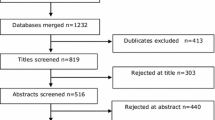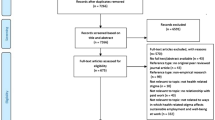Abstract
Purpose
Young people with disabilities are persistently under-employed and experience concerning rates of discrimination and ableism in looking for work and within the workplace. Focusing on youth is salient because rates of ableism are often higher among younger ages compared to older. The objective of this systematic review was to explore the experiences and impact of workplace discrimination and ableism among youth and young adults with disabilities.
Methods
Systematic searches of seven databases from 2000 to 2021 were conducted. Four reviewers independently applied the inclusion criteria, extracted the data and rated the study quality.
Results
Of the 39 studies meeting our inclusion criteria, they represented 516,281 participants across eight countries over a 20-year period. The findings highlight the rates of workplace ableism, factors affecting workplace ableism (i.e., type of disability, gender, education level, lack of employers’ knowledge about disability), ableism in job searching and anticipated ableism. The review also noted the impact of workplace ableism, which included pay discrimination, lack of job supports and social exclusion, job turnover and unemployment, and discrimination allegations and charges.
Conclusions
Our findings reveal the stark prevalence of workplace ableism among youth and young adults with disabilities. There is an urgent need for further in-depth research to understand youth’s lived experiences of ableism and the development of solutions to address it so they can be included in a meaningful and respectful way in the workplace.

Similar content being viewed by others
References
Lindsay S, et al. A systematic review of the benefits of hiring people with disabilities. J Occup Rehabil. 2018;28:634–55.
Tamtik M, Guenter M. Policy analysis of equity, diversity and inclusion strategies in Canadian universities: How far have we come? Can J High Educ. 2019;49(3):41–56.
Wolbring G, Lillywhite A. Equity/equality, diversity, inclusion (EDI) in universities: The case of disabled people. Societies. 2021;11:1–35.
Morris S, Fawcett G, Brisebois L. A demographic, employment and income profile of Canadians with disabilities aged 15 years and over. Statistics Canada: Ottawa; 2018.
Brown N, Leigh J. Ableism in academia: where are all the disabled and ill academics? Disability & Society, 2018. 33(6): pp. 985–9.
Mellifont D, et al. The ableism elephant in the academy: a study examining academia as informed by Australian scholars with lived experience. Disabil Soc. 2019;3–4:1180–99.
Friedman H, Lopez-Pulmarejo T, Friedman L, The largest minority group: the disabled. BQuest, 2006: p. 1–14.
Harder J, Keller V, Chopik W. Demographic, experiential, and temporal variation in ableism. J Soc Issues. 2019;75(3):683–706.
Dunn D. Outsider privileges can lead to insider disadvantages: Some psychosocial aspects of ableism. J Soc Issues. 2019;75(3):665–82.
Shaw L, et al. Employee and employer characteristics associated with elevated risk of filing disability harassment charges. J Vocat Rehabil. 2012;36:187–97.
Branco C, Ramos M, Hewstone M. The association of a group-based discrimination with health and well-being: A comparison of ableism with other ‘isms’. J Soc Issues. 2019;75(3):814–46.
Lindsay S. Discrimination and other barriers to employment for teens and young adults with disabilities. Disabil Rehabilitation. 2011;33(15–16):1340–50.
Lindsay S, et al. Disclosure and accommodation and workplace accommodations among youth with disabilities. Disabil Rehabilitation. 2019;41(16):1914–24.
Roessler R, et al. Workplace discrimination outcomes and their predictive factors for adults with multiple sclerosis. Rehabilitation Couns Bull. 2007;50(3):139–52.
Shaw L, Chan F, McMahon B. Intersectionality and disability harassment: The interactive effects of disability, race, age and gender. Rehabilitation Counselling Bulletin. 2012;55(2):82–91.
Shier M, Graham J, Jones M. Barriers to employment as experienced by disabled people: a qualitative analysis in Calgary and Regina, Canada. Disability & Society, 2009. 24(1): pp. 63–75.
Barnes C, Mercer G. Disability, work, and welfare: challenging the social exclusion of disabled people. Work Employ Soc. 2005;19(3):527–45.
Nations., U., Convention on the Rights of Persons with Disabilities, in GA Res. 2006. p. 106.
Temple J, Kelaher M, Williams R. Discrimination and avoidance due to disability in Australia: evidence from a national cross sectional survey. BMC Public Health. 2018;18:1347–60.
Lindsay S, et al. Gender matters in the transition to employment for young adults with physical disabilities. Disabil Rehabilitation. 2018;41(3):319–32.
Arnett J. Emerging adulthood: What is it, and what is it good for? Child Dev Perspect. 2007;1(2):68–73.
Lindsay S, et al. Career aspirations and workplace expectations among youth with physical disabilities. Disability & Rehabilitation; 2020.
Brennan S. Participation and activity limitation survey, 2006: Facts on learning limitations. Statistics Canada: Ottawa; 2009.
Li J, et al. The workplace discrimination experiences of middle-age and younger adult workers with disabilities: Results from the national EEOC ADA research project. J Vocat Rehabil. 2016;45:365–76.
McMahon B, et al. Hiring discrimination against people with disabilities under the ADA: characteristics of charging parties. J Occup Rehabil. 2008;18:122–32.
Canadian Human Rights Commission. Persons with disabilities continue to be marginalized in Canadian society. 2015, Government of Canada: Ottawa. p. https://www.canada.ca/en/human-rights-commission/news/2015/12/persons-with-disabilities-continue-to-be-marginalized-in-canadian-society-chrc.html.
World Health Organization. International Classification and Functioning. 2007.
Liberati A, et al. The PRISMA statement for reporting systematic reviews and meta-analyses of studies that evaluate health care interventions: explanation and elaboration. PLoS Med. 2009;6(7):e1000100.
Petticrew M, Roberts H. Systematic reviews in the social sciences: A practical guide. John Wiley & Sons; 2008.
Kmet LM, Lee RC, Cook LS. Standard quality assessment criteria for evaluating primary research papers from a variety of fields. Vol. 22: Alberta Heritage Foundation for Medical Research Edmonton; 2004.
Baldwin M, Marcus S. Perceived and measured stigma among workers with serious mental illness. Psychiatric Serv. 2006;57(3):388–92.
Chiu M, Chan K. Community attitudes towards discriminatory practice against people with severe mental illness in Hong Kong. Int J Soc Psychiatry. 2007;53(2):159–74.
Bjornshagen V. The mark of mental health problems: A field experiment on hiring discrimination before and during COVID-19. Soc Sci Med. 2021;283(114181):1–8.
Woodgate R, et al. The wicked problem of stigma for youth living with anxiety. Qual Health Res. 2020;30(10):1491–502.
Ballard L, et al. Experiences of adolescents living with Silver-Russell syndrome. Archives of Disability in Childhood. 2021;106(106):1195–201.
Booth S, Price E, Walker E. Fluctuation, invisibility, fatigue: the barriers to maintaining employment with systemic lupus erythematous–results of an online survey. Lupus. 2018;27:2284–91.
Borg S, et al. Employment outcomes following spinal cord injury: a population-based cross-sectional study in Australia. Spinal Cord. 2021;59:1120–31.
Chhabra G. Turning a blind eye to employers’ discrimination? Attitudinal barrier perceptions of vision impaired youth from Oslo and Delhi. 36: Disability & Society; 2021. pp. 1688–711.
Crom D, et al. Workplace experiences and turnover intention among adult survivors of childhood cancer. J Cancer Surviv. 2018;12:469–78.
Feuerstein M, et al. Pattern of workplace disputes in cancer survivors: a population study of ADA claims. J Cancer Survivors. 2007;1:185–92.
Goodall J, et al. Stigma and functional disability in relation to marriage and employment in young people with epilepsy in rural Tanzania. Seizure. 2018;54:27–32.
Hawley C, McMahon B, Roessler R. A comparison of workplace discrimination experiences for youth and adults with epilepsy. J Rehabilitation. 2012;78(2):27–35.
Gulik E, et al. Experiences, perspectives and expectations of adolescents with juvenile idiopathic arthritis regarding future work participation; a qualitative study. Pediatr Rheumatol. 2020;18:33–44.
Hanson H, et al. Experiences of employment among people with juvenile idiopathic arthritis: a qualitative study. 40: Disability & Rehabilitation; 2018. pp. 1921–8.
Shaw K, et al. The prevocational and early employment needs of adolescents with juvenile idiopathic arthritis: the adolescent perspective. Br J Occup Therapy. 2006;69(3):98–105.
Lindsay S, McPherson A, Maxwell J. Perspectives of school-work transitions among youth with spina bifida, their parents and health care providers. Disabil Rehabilitation. 2017;39(7):641–52.
Lindsay S, et al. Applying an ecological framework to understand transition pathways to post-secondary education for youth with physical disabilities. Disabil Rehabilitation. 2018;40(3):277–86.
Ripat J, Woodgate R. The importance of assistive technology in the productivity pursuits of young adults with disabilities. Work. 2017;57:455–68.
West S, et al., Workplace discrimination and missing limbs: The national EEOC ADA research project. Work, 2005: p. 27–35.
Murray P, et al. Impact of end-stage kidney disease on academic achievement and employment in young adults: A mixed methods study. J Adolesc Health. 2014;55:502–12.
Merrells J, Buchanan A, Waters R. We feel left out: Experiences of social inclusion from the perspective of young adults with intellectual disability. J Intell Dev Disabil. 2019;44(1):13–22.
Plexico L, et al. The influence of workplace discrimination and vigilance on job satisfaction with people who stutter. J Fluen Disord. 2019;62:105725.
Cramm J, et al., Comparison of barriers to employment among youth with and without disabilities in South Africa. Work, 2013: p. 19–24.
Fabian E, et al., The road to work: Youth with disabilities and their views on employment and the ADA. Rehabilitation Research, Policy and Education, 2021;35(2): 70–83.
Hernandez B, et al. Perspectives of people with disabilities on employment, vocational rehabilitation and Ticket to Work program. J Vocat Rehabil. 2007;27:191–201.
Jones A, Finkelstein R, Koehoorn M. Disability and workplace harassment and discrimination among Canadian federal public service employees. Can J Public Health. 2018;109:79–88.
Magee W. Effects of illness and disability on job separation. Social Science and Medicine, 2004. 58.
McMahon M, et al. Workplace discrimination and learning disabilities in America: Characteristics of charging parties and employers. J Vocat Rehabil. 2016;45:295–300.
Toldra R, Santos M. People with disabilities in the labor market: Facilitators and barriers. Work. 2013;45:553–63.
Gunderson M, Lee B. Pay discrimination against persons with disabilities: Canadian evidence from PALS. Int J Hum Resource Manage. 2016;27(14):1531–49.
Mann D, Wittenburg D. Starting behind: Wage and employment differentials between young adults with and without disabilities. J Disabil Policy Stud. 2015;26(2):89–99.
Fabian E. Urban youth with disabilities: Factors affecting transition employment. Rehabilitation Counselling Bulletin. 2007;50(3):130–8.
Lindsay S, et al. An ecological approach to understanding barriers to employment for youth with disabilities compared to their typically developing peers: Views of youth, employers, and job counselors. Disabil Rehabilitation. 2015;37(8):701–11.
Pace J, Shin M, Rasmussen S. Understanding attitudes toward people with Down syndrome. Am J Med Genet. 2010;152A:2185–92.
Toldrá RC, Santos MC. People with disabilities in the labor market: facilitators and barriers. Work. 2013;45(4):553–63.
Bjelland M, et al. Age and disability employment discrimination: Occupational rehabilitation implications. J Occup Rehabil. 2010;20:456–71.
Roessler R, Hawley C, McMahon B. Employment discrimination experiences of youth with epilepsy: A comparative analysis. J Vocat Rehabil. 2012;36:149–58.
Tomas V, Ahmed H, Lindsay S, Unravelling the complexities of workplace disability disclosure among persons with non-visible disabilities: A qualitative meta-ethnography. Journal of Occupational Rehabilitation, 2021. in press.
Lindsay S, et al. A framework for developing employer’s disability confidence. Equality. Divers Inclusion. 2019;38(1):40–55.
Lindsay S, et al. Systematic review of the role of gender in finding and maintaining employment among youth and young adults with disabilities. J Occup Rehabil. 2018;28(2):232–51.
Lindsay S, et al. An ecological approach to understanding barriers to employment for youth with disabilities compared to their typically developing peers: Views of youth, employers, and job counselors. Disabil Rehabil. 2015;37(8):701–11.
Burchardt T. Aiming high: The educational and occupational aspirations of young disabled people. Support for Learning. 2004;19(4):181–6.
Wilton R. Disability disclosure in the workplace. Just Labour. 2006;8:24–30.
Harpur P. Rights of persons with disabilities and Australian anti-discrimination laws: What happened to the legal protections for people using guide or assistance dogs? Univ Tasmania Law Rev. 2010;29(1):49–79.
Schur L, Ameri M, Kruse D. Telework after COVID: A silver lining for workers with disabilities? J Occup Rehabil. 2020;30:521–36.
Fuentes M, Houtrow A, Gutierrez V. Ableism and quality of life during the coronavirus pandemic. J Hosp Med. 2021;16(5):316–8.
McDonald K, Keys C, Balcazar F. Disability, race/ethnicity and gender: themes of cultural oppression, acts of individual resistance. Am J Community Psychol. 2007;39:145–61.
Author information
Authors and Affiliations
Corresponding author
Additional information
Publisher’s Note
Springer Nature remains neutral with regard to jurisdictional claims in published maps and institutional affiliations.
Electronic supplementary material
Below is the link to the electronic supplementary material.
Rights and permissions
About this article
Cite this article
Lindsay, S., Fuentes, K., Tomas, V. et al. Ableism and Workplace Discrimination Among Youth and Young Adults with Disabilities: A Systematic Review. J Occup Rehabil 33, 20–36 (2023). https://doi.org/10.1007/s10926-022-10049-4
Accepted:
Published:
Issue Date:
DOI: https://doi.org/10.1007/s10926-022-10049-4




